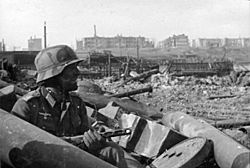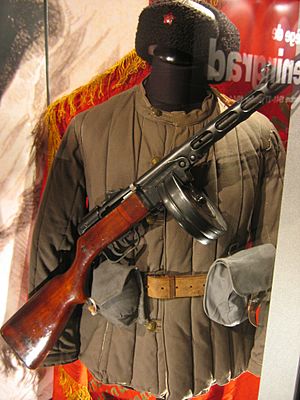PPSh-41 facts for kids
Quick facts for kids PPSh-41 |
|
|---|---|

PPSh-41 with drum magazine.
|
|
| Type | Submachine gun |
| Place of origin | |
| Service history | |
| In service | 1941–present |
| Used by | See Users |
| Wars | |
| Production history | |
| Designer | Georgi Shpagin |
| Designed | 1941 |
| Manufacturer | Many |
| Produced | 1941–1947 |
| No. built | Around 6,000,000 |
| Variants | See Different kinds of PPSh-41 |
| Specifications | |
| Mass | 3.63 kg (8.0 lb) (without magazine) |
| Length | 843 mm (33.2 in) |
| Barrel length | 269 mm (10.6 in) |
|
|
|
| Rate of fire | 900 rounds per minute |
| Effective firing range | 150 meters |
The PPSh-41 is a famous submachine gun from the Soviet Union. Its full name means "Shpagin machine pistol." It was designed by Georgi Shpagin in 1941. This gun was made to be simpler and cheaper than older models.
The PPSh-41 was easy to make in large numbers. It was used a lot during World War II and the Korean War. It was one of the most produced submachine guns of its time. Even today, some copies of the PPSh-41 are still used in different parts of the world.
Contents
History of the PPSh-41
Why the PPSh-41 Was Created
The idea for the PPSh-41 came from the Winter War against Finland. During this war, soldiers found that submachine guns were very useful. They were great for fighting in small, close spaces.
The PPSh-41 was developed in the middle of 1941. Many factories in Moscow started making them. Local leaders were in charge of making sure enough guns were produced.
Making Many PPSh-41s Quickly
Hundreds of PPSh-41s were made by November 1941. Over the next five months, 155,000 more were built. By spring 1942, factories were making about 3,000 guns every day.
The PPSh-41 was designed to be made very fast. Its parts, except for the barrel, could be made by workers who were not highly skilled. The PPSh-41 had 87 parts, which was less than the older PPD-40 model. It took only 7.3 hours to make a PPSh-41, while the PPD-40 took 13.7 hours.
To make barrels faster, workers often used rifle barrels. They would cut a M1891 Mosin–Nagant rifle barrel in half. Each half could then be changed to make two PPSh-41 barrels.
PPSh-41 in World War II
The PPSh-41 became very popular, even with German soldiers. They often used captured PPSh-41s against their enemies. It was the second most used submachine gun by German forces in World War II.
The German army even changed some PPSh-41s to use their own bullets. These changed guns were called the MP41(r). Guns that were not changed were called the MP717(r). The German military also printed special manuals in German. These taught their soldiers how to use the PPSh-41.
The Soviet Union also tried using the PPSh-41 on planes. They put many of these guns on some of their planes for close air support.
By the end of World War II, over 6 million PPSh-41s had been made. After the Battle of Stalingrad, it became the most common small arms weapon in the Red Army. Sometimes, whole groups of soldiers were given only PPSh-41s. This gave them a lot of firepower in close-range fights.
PPSh-41 in the Korean War
After World War II, many PPSh-41s were given to countries that were allies of the Soviet Union. They were also given to communist guerilla fighters.
The armies of North Korea and China used many PPSh-41s during the Korean War. They also used copies made in their own countries, like the North Korean Type 49 and the Chinese Type 50.
The PPSh-41 was used a lot throughout the Korean War. It was not always very accurate, but it was great for close-range battles. This was because it could fire bullets very fast and held many bullets in its magazine. These close fights often happened at night in Korea.
Soldiers from the United Nations sometimes had trouble fighting back against attacks from communists using the PPSh-41. Some U.S. officers even said it was the best gun of the war. While not as accurate as the American M1 Garand or M1 carbine, it offered more power up close.
Features of the PPSh-41
The PPSh-41 used a 7.62x25mm Tokarev bullet. This was the main bullet for Soviet pistols and submachine guns.
The gun weighed about 12 pounds (5.45 kg) with a full 71-round drum magazine. With a smaller 35-round magazine, it weighed 9.5 pounds (4.32 kg). The PPSh-41 could fire an amazing 900 rounds per minute. This was very fast compared to other submachine guns of World War II.
The PPSh-41 did not have a special grip. Soldiers usually held it behind the drum magazine or at the bottom of the drum. From 1942, 35-round box magazines were also used. However, Soviet soldiers in World War II often preferred the larger 71-round drum magazine.
The drum magazine was copied from a Finnish gun. It held 71 bullets. But it was slower and harder to load than the box magazine. The box magazine became more popular after 1942. Even though it held fewer bullets, the box magazine made the gun easier to hold.
The PPSh-41 had an "open bolt" design. This meant it could accidentally fire if it was dropped on a hard surface.
Different Kinds of PPSh-41
Because the Germans captured so many PPSh-41s, they started a program. They changed some of these guns to fire German bullets called the 9mm Parabellum. The German army officially called these changed guns the MP41(r). PPSh-41s that were not changed were called the MP717(r). They used 7.63x25mm Mauser bullets instead of the Soviet ones.
During World War II, an even simpler submachine gun was made. It was called the PPS-43. But it did not completely replace the PPSh-41 during the war.
Other Versions of the PPSh-41
- Type 50: This was a Chinese copy of the PPSh-41.
- Type 49: This was a North Korean copy. It could only use drum magazines.
- M-49: This was a version made in Yugoslavia. It used the PPSh-41's design but had some important differences.
- PPS-50: This was a Canadian, semi-automatic version. It used a 30-round box magazine or a 50-round drum magazine.
- SKL-41: This was a German, semi-automatic version. It started selling in 2008 and fires the 9mm Parabellum bullet.
Who Used the PPSh-41?

 Albania
Albania Cuba
Cuba Guinea
Guinea Hungary: They captured and used PPSh-41s in the early 1940s.
Hungary: They captured and used PPSh-41s in the early 1940s. Laos
Laos Nazi Germany: Used captured and changed PPSh-41s.
Nazi Germany: Used captured and changed PPSh-41s. North Korea: Made their own copies called Type 49.
North Korea: Made their own copies called Type 49. People's Republic of China: Made their own copies called Type 50.
People's Republic of China: Made their own copies called Type 50. Soviet Union: Used by the Red Army starting in 1942.
Soviet Union: Used by the Red Army starting in 1942. Vietnam: The Vietcong often used a copy called the K-50M during the Vietnam War.
Vietnam: The Vietcong often used a copy called the K-50M during the Vietnam War.
Related pages
Images for kids
-
A Red Army soldier armed with a PPSh-41 marches a German soldier into captivity after the Battle of Stalingrad, 1943.
See also
 In Spanish: PPSh-41 para niños
In Spanish: PPSh-41 para niños





